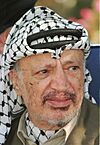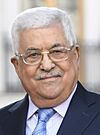President of the Palestinian National Authority facts for kids
The President of the Palestinian National Authority is the top political leader in the Palestinian National Authority (PNA). This role is similar to a country's head of state. The president chooses the prime minister of the Palestinian National Authority. The prime minister usually needs approval from the Palestinian Legislative Council. Both the president and the prime minister share the power to run the government.
Contents
How the President's Role Was Created
The Palestinian National Authority (PNA) was set up in 1994 by the Gaza–Jericho Agreement. At first, the Basic Law, which is like the PNA's constitution, said the president had all the power. The president could pick and remove ministers and lead government meetings. This was a "presidential system."
But in 2003, things changed. Other countries and even people within President Yasser Arafat's own party, Fatah, wanted him to share power. So, a prime minister was appointed. The Basic Law was changed, making the system "semi-presidential." This means the president and prime minister now share responsibility for leading the government. The president had to give up some of his powers to the prime minister.
What the President Can Do
The 2003 Basic Law explains the president's powers. Here are some of them:
- The president chooses the prime minister and can remove them. However, the prime minister is the one who forms the government, and the Palestinian Legislative Council (PLC) must approve it.
- The president can approve or send back laws passed by the PLC. But the president does not make laws; that's the PLC's job.
- If the PLC is not meeting, the president can issue urgent orders that act like laws. These orders must be shown to the PLC later. If the PLC doesn't approve them, they stop being valid.
- The president can declare a state of emergency for up to 30 days if national security is at risk. The PLC must approve any extensions to this period. During an emergency, the PLC cannot be shut down.
- The president is the Commander-in-Chief of the Palestinian Forces. This means they are in charge of the military.
- The president appoints and removes the PNA's representatives to other countries.
Choosing a President and Their Term
The first president was meant to serve during a temporary period. The next president would be chosen by a direct vote of Palestinians in the occupied Palestinian areas. This temporary period was set for five years, starting in 1994. So, the first president was appointed in 1994 and then elected in 1996 to serve until 1999.
The Basic Law says that the President of the Palestinian National Authority must be elected by the Palestinian people. The Oslo II Accord also states that the president and the Palestinian Legislative Council should be elected at the same time.
At first, the Basic Law didn't plan for presidents to be re-elected because it was only for a temporary period that was supposed to end in 1999.
Changes to the President's Term in 2005
In 2005, the Basic Law was updated. This change said that the president's term would be "four years" instead of just a temporary phase. It also limited the president to serving only two terms in a row. The law also set the term for the Palestinian Legislative Council to four years. It said that the president and the council members should be elected at the same time.
The 2005 law also stated that the current Legislative Council's term would end when new members took their oath. This meant the new four-year terms for both the president and the council would start with the next council election.
Challenges with Presidential and Parliament Terms
The 2005 laws aimed to have the president and parliament elected at the same time for four-year terms. However, President Arafat died before these laws were fully in place. Mahmoud Abbas was elected president in 2005, but the old parliament stayed.
To make the terms match, the law said the next presidential election should happen with the election of the second Legislative Council. But no presidential election happened then. Instead, Abbas, elected in 2005, stayed in office. This led to questions about when his first term officially began.
In 2008, a legal office in Ramallah said Abbas's term should be extended until January 25, 2010, to match the parliament's term. But after the 2007 split of the Palestinian government, there was another legal office in Gaza that disagreed. They argued that the Basic Law was more important than the Elections Law. This disagreement caused confusion and concerns about having two different presidents.
When a President's Term Ends
A president's term ends when their elected period is over. It can also end in special situations like death, resignation (if the PLC accepts it), or if a court rules they can no longer serve. If the president's office becomes empty, the speaker of the PLC temporarily takes over. New elections must then be held within 60 days to choose a new president.
Past Presidents
Yasser Arafat
When the Palestinian Authority was first set up, there were no presidential elections. So, Yasser Arafat, who was the leader of the PLO and helped create the Oslo Accords, became the first President of the Palestinian National Authority in 1994. He was formally elected in 1996.
Arafat remained president until he died in 2004. After his death, the House Speaker, Rauhi Fattouh, became the acting president.
Mahmoud Abbas
New elections were held in 2005, and Mahmoud Abbas won. His term officially ended in 2009, which caused a political problem. Abbas extended his own term by one year and is recognized as president by the government in the West Bank. However, in the Gaza Strip, Aziz Dweik, the speaker of the Palestinian Legislative Council, was recognized as acting president. From 2014 to 2016, both sides recognized Rami Hamdallah as head of government and Mahmoud Abbas as president.
What "Ra'ees" Means
The Arabic word Ra'ees (رئيس) can mean "President" or "Chairman" in English.
The use of "President" for the Palestinian leader can be a sensitive topic. Some people think it suggests that Palestine is a fully independent state, which is still debated. Others prefer "Chairman" to avoid implying statehood.
In the past, the 1995 Israeli-Palestinian agreement used the Arabic term Ra'ees. A letter from Yasser Arafat said he would use "Chairman (Ra'ees in Arabic) of the Palestinian Authority" or "Chairman of the PLO," but not "President of Palestine."
Today, the Palestinian National Authority usually uses "president" in English. Israel often uses "chairman." News organizations and the United States sometimes use different terms depending on the situation.
List of Presidents (1994–Present)
| No. | Portrait | Name (Birth–Death) |
Term | Political party | |||
|---|---|---|---|---|---|---|---|
| Took office | Left office | Duration | |||||
| 1 |  |
Yasser Arafat (1929–2004) |
5 July 1994 | 11 November 2004 † | 10 years, 129 days | Fatah (PLO) |
|
| – |  |
Rawhi Fattouh (born 1949) Interim President |
11 November 2004 | 15 January 2005 | 65 days | Fatah (PLO) |
|
| 2 |  |
Mahmoud Abbas (born 1935) |
15 January 2005 | Incumbent | 20 years, 330 days | Fatah (PLO) |
|
| – |  |
Aziz Dweik (born 1949) Interim President |
15 January 2009 | Incumbent | 16 years, 330 days | Hamas | |
See also
- Chairman of the Palestine Liberation Organization
- President of the State of Palestine
- Prime Minister of the Palestinian National Authority
- Speaker of the Palestinian Legislative Council
- Leaders of Palestinian institutions

